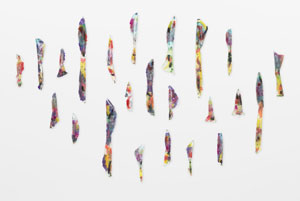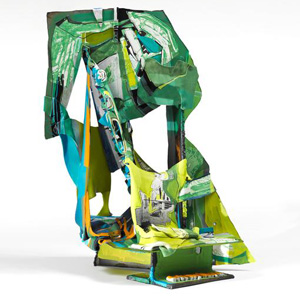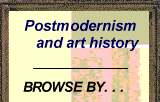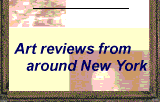From Tribeca to Hollywood
John Haberin New York City
Richard Van Buren and Abstraction
Hadi Falapishi and Erin M. Riley
Richard Van Buren might seem the least likely artist to call a show "Hollywood High," but look again. If the high wears wore off soon enough, that's show business—and some serious art. It should have you thinking about the state of abstract art today as well.
Van Buren found his voice at the very peak of late modern art, and an exhibition spanning his career shows how much and how little has changed. The same dilemma of old and new faces many a younger artist, too: oh, that again? Contemporary hybrids of media and genres can seem invigorating or simply exhausted. Either way, they are everywhere, with some of the most creative down in Tribeca, but first van Buren. As the song goes, "Hooray for Hollywood." 
Hooray for Hollywood
Born in upstate New York, Richard Van Buren studied in San Francisco, about as far Hollywood's "screwy ballyhooey" as California can get. I quote the old song, from the 1930s musical that also brought "That's Entertainment," but Van Buren is hardly a mass entertainer. He has since settled down in Maine, where an expectant film audience could hear the silence. He is a bit old to relive high school at that. His show repurposes work from 1969 and 1970, when he was already in his thirties, along with the new. Early and recent work could be downright jarring set side by side, but watch what happens as you follow the course between them.
I have skipped over a few years. For much of his creative life, he was a true New Yorker. The gallery calls him "inextricable from the creative firmament" of the city, where he taught at the School of Visual Arts (or SVA). It goes on to compare him to Sol LeWitt, Robert Morris, and Robert Smithson—not someone from LA for whom Minimalism means a one-car garage. Yet he found his own path from the machine made to seashells and costume jewelry. They bring his work closer and closer to trash for its own sake while nurturing art as object, and he calls it sculpture.
Bare or stuffed to the gills, it still hangs on the wall, and it is still for me a kind of painting. Not that it needs much in the way of paint when it can have fiberglass and polychrome resin. It starts with subdued colors, only to add glitter to tart reds and blues. In the process it moves from relief to assemblage—and from Minimalism to "pattern and decoration." Industrial materials become transparent casings to keep art in its place. It stresses hand assembly while seeming never quite at home.
It relies on geometry all the same to give shape to the spectacle. Early vertical slabs jerk aside at the end, like feet that have forgotten how to dance. A shift in color at the edge might pass for a cheap metal frame. Slightly later work adds a second slab or wiggles along the vertical. Van Buren is struggling against his own formula and liking it. It runs to half a dozen or more pieces before breaking free.
By then the stuffing is its own spectacle, in direct violation of the old demand from Frank Stella: what you see is no longer what you see. You have to work to decipher what Van Buren he painted, if anything, and what he assembled. How can such bright and shiny art cast only gray shadows? But wait, there are also light blue shadows—except that they are not shadows at all, but feathers. The busiest work, with what must be more than thirty shorter pieces, fits them all into a circle.
What, though, governs his choices beyond the glitter, and whatever happened to Hollywood? An artist who once shared a gallery with Morris is nowhere near as visible, only partly a matter of physical distance from New York. Are Minimalism and "pattern and decoration" too out of fashion—or too hard to fit into a single story? There is, though, a story asking to be heard about abstraction. Van Buren is still exploring geometry and color.
Is it still abstract?
You have seen it all by now, which is what makes it abstract art. The up side is that it can push the artist to rethink the very nature of the image. Coming to Iva Gueorguieva, you could have no clue what you are seeing. These are more or less medium-sized paintings, but with a lot going on. Is this formalism? Not exactly, but the more the artist works the surface, the more it returns to the painting's center in the human image.
Gueorguieva layers on the canvas, with nearly white, wide-open fields that unify the whole. They serve, though, as a packed receptacle for brushwork as drawing. It dares you to decide whether the detail lands above or below. At first glance, the broader fields flatten the canvas and bring it closer to abstraction. Over time, though, they give a sense of a human or inhuman body. As paint it looks well grounded, but as image it can fly.
 The gallery speculates that the figure is the archangel Gabriel, and once representation takes visible shape it is hard to make it disappear. Is there a story here? Maybe one about the art scene now that Postmodernism has given way to something less skeptical. Artists all over are turning to modernist tropes for their energy even if they seem more than a little old. Sarah Blaustein returns to the concentric swirls and spring colors of Post-Impressionism and early Modernism itself. You might be a trifle embarrassed to feel it in motion.
The gallery speculates that the figure is the archangel Gabriel, and once representation takes visible shape it is hard to make it disappear. Is there a story here? Maybe one about the art scene now that Postmodernism has given way to something less skeptical. Artists all over are turning to modernist tropes for their energy even if they seem more than a little old. Sarah Blaustein returns to the concentric swirls and spring colors of Post-Impressionism and early Modernism itself. You might be a trifle embarrassed to feel it in motion.
Robert Janitz relishes his place in the art world, even if you had hardly noticed him. Born in Germany, based in Mexico, and now here, he is proud of it. His latest work, "1001 Nights [ + 1 ]," claims the power of a mythmaker with its very title—and, with the bracketed subtitle, the power to one-up Islamic myth. He sees himself as competing with the "swirling atmosphere" of New York. Never mind that most artists I know have resigned themselves to be pretty much out of the competition and faithful to their art. Janitz would call that surrender.
His gallery did as much as any to nurture artists between abstraction and portraiture like Katherine Bernhardt, Katherine Bradford, and Lily Ludlow, and Janitz hopes he has the formula. He lays down simplified bust-length portraits against a vaguely blank, vaguely patterned field as studies in brushwork itself. Then he packs what should be the face with broad, busy brushstrokes. They can roughly take the course of facial features or, in other paintings, take off on their own. Both sets of work serve simultaneously as marks of erasure and of three-dimensional space. An admixture of flour, oil, and wax keeps the colors mute and the faces in your face.
They leave me seriously unconvinced, but they only affirm how much painting still matters. Stick to abstraction or imagery and find yourself stuck with both. Or stop with abstraction as a metaphor—or a metaphor as abstraction. A map is an old metaphor for art indeed, and Lena Henke maps Manhattan as "The City Transformed." It looks ever so handmade, like a relic, as a nostalgic tribute to the city. So what if you cannot pin down just what about New York Henke is mapping, least of all its art?
Recent history?
Must artists recover the past? Can anyone? Galleries themselves are returning to territory that they were largely giving up when I was just discovering art. Back in the days of fewer and fewer affordable Soho lofts and cutting-edge Soho galleries, Tribeca was already becoming the place to be for an exploding financial and party sector. Do not even ask how those two ever got along. But greed, you may remember, was good.
I never belonged there, but I did watch uncertainly as the likes of Julian Schnabel and, in different ways, the "Pictures generation" upstaged Modernism. Now artists and dealers are more likely to approach their own past with caution. Hadi Falapishi, for one, seems to have little patience for more than cartoons. He paints faces in acid colors that positively should cartoons. And yet this is his past, too.
That is because it is also art. He nurtures the sense that each may provide a glimpse of more. Pairs of them crowd together in paintings that speak of tension—or is it all in fun? Falapishi leaves that possibility open, too, because he seems to prefer that art have fun. You have seen these motifs before, like a sailing ship with a hasty smile on its sail, like a painting or a living thing? This might almost be Postmodernism quoting René Magritte or Magritte quoting Postmodernism. Surrealism it is not.
In other words, it is all about ambivalence and all about the past. (They go together.) He appeared with the gallery in the 2024 art fairs, but now he takes the weight of history such as it is. He calls it "Gut Feelings (Trauma Dumps and Love Bombs)." Be forewarned. I had mixed feelings about its cast of characters, but it prompted me to seek out the past for myself.
Erin M. Riley looks to her own past, and yet she, too, finds tradition in art. Like Kay Sekimachi, at Falapishi's gallery, she turns to weaving while calling it a personal memory. She works in loosely woven wool and cotton, , the clumsier but more ambitious the better. It incorporates images of video looking older and clumsier than it would appear in life. It conveys stories, too, of the girl home alone making it to this point as a woman. As one frankly clumsy painted title has it, You Broke My Heart.
Riley shares her gallery with Elizabeth Glaessner, whose panted alter ego emerges out of a haze, a swamp, or a dream. Riley, though, has even better stories, if you can decipher them. Just try to find all the fragments of her suspended in compressed space. Try to believe from spare white outlines of something uncertain against the deeper colors and approach to darkness of Somebody Cares. She may still feel the fresh tar on a newly paved country road. She may remember her grandfather as someone solid though those who come to him for comfort are question marks. She has no choice but to see a rose and a teddy bear and to believe that they belong to her.

Richard Van Buren ran at Garth Greenan through August 15, 2025, Iva Gueorguieva at Derek Eller through July 11, Sarah Blaustein at Hesse Flatow through June 7, Robert Janitz at Canada through July 11, Lena Henke at Bortolami annex through June 21, Hadi Falapishi and Kay Sekimachi at Andrew Kreps through November 1, Erin M. Riley and Elizabeth Glaessner at P.P.O.W. through October 18.




